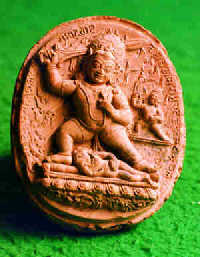|
Tsha Tsha
( 2005-10-17 )

Clay molded miniature Buddhist images, precious treasures left by Tibetan ancestors, are called tsha tsha in Tibetan, and represent a typical and classic form of artistic expression in TibetanBuddhism. Because of the Tibetans' artistic talents and deep devotion to their religion, tsha tsha is a rare inheritance to the world and an irreplaceable treasure of human civilization.
Tsha tsha, a Tibetan transliteration of the Sanskrit word, is the clay votive tablet (designating the fulfillment of a vow) in Tibetan Buddhism. Such tablets are made of clay and earth mixed with the bone ash of late Lamas.
Whether they are the relief images made from a one-sided mold or are round stupas (domed Buddha shrines) completed by a two-sided mold, all of them are called tsha tsha.
Tibetan monks and common people make tsha tsha to accumulate Buddhist merit. The completed tablet is mainly used to fill the inner shrines of bigger stupas or statues. Tsha tshas are also used to dispel illness or pray for good luck. When they are in use, Tsha Tshas are worshiped at places such as monasteries, Mani piles, snow mountains, peaks, and caves.
In the 13th century, with the introduction of Tibetan Buddhism, the Tibetan art of tsha tsha was introduced to other places of China. Despite repeated destruction caused by nature and human disasters, many tsha tshas can still be found widely distributed in places throughout China.
As the molded works are not difficult to make and the material is easily obtainable, tsha tshas can be found almost everywhere in Tibet, although this molded art, typical of Tibetan Buddhist arts, is rarely known to outsiders. Hence there is an urgent need to inform more common people about this special art.
Not only are tsha tshas valuable for collection, they are also important in Tibetan study, including the study of religion, arts, culture relics, and the culture influences between Tibetan and Han peoples.
|

